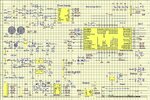EthanAlef
Newbie level 5
I use two LDOs to obtain digital voltages. Finally I get 3.3V at the end.
However, when I connected something, such wifi module, which must be driven by 3.3V, the voltage at that terminal drops down to 1.9V.
I am beginner in electronics design. My only knowledge tells me I should add an extra capacitor at the terminal, but I don't know what value should it be...
Or, if there any solution to such problem? Please see the attached.

However, when I connected something, such wifi module, which must be driven by 3.3V, the voltage at that terminal drops down to 1.9V.
I am beginner in electronics design. My only knowledge tells me I should add an extra capacitor at the terminal, but I don't know what value should it be...
Or, if there any solution to such problem? Please see the attached.


